Bring Back the Seaplane
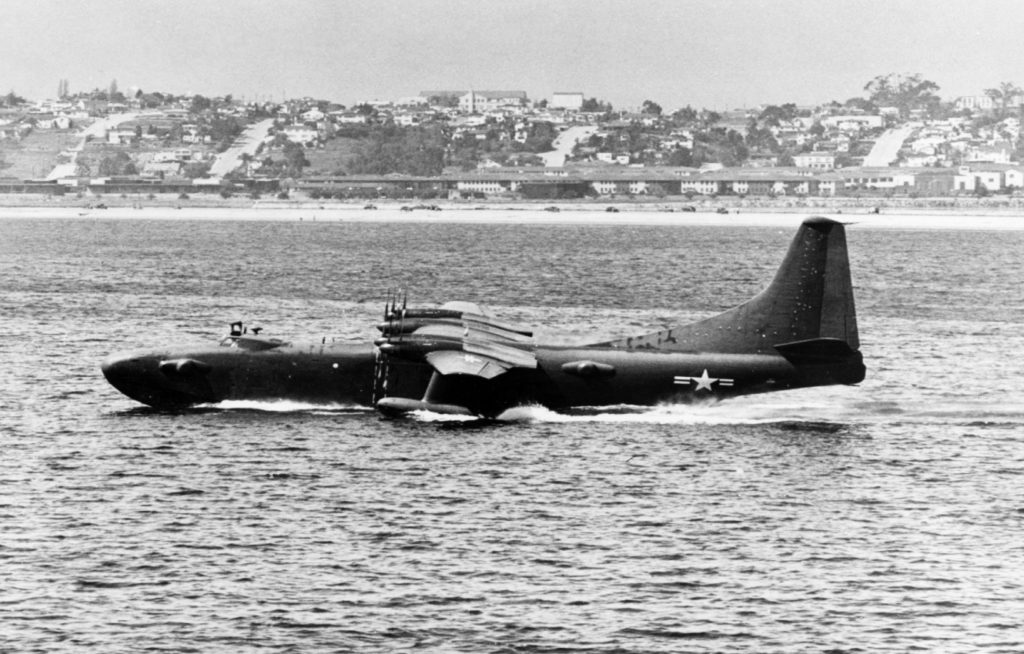
On December 8, 1941, Japan attacked the Philippines and destroyed nearly half of the U.S. Army Air Corps’ bombers along with a third of its fighters on the ground. Yet, 43 of 45 Navy patrol aircraft survived the day. The reason for such a stark difference in survival is simple: In accordance with pre-war plans, the 45 aircraft of Patrol Wing 10 had dispersed to various lakes, beaches, rivers, and bays throughout the Philippines. The aircraft — PBY Catalina seaplanes — continued the fight from their ever-changing sea bases. Japan was left hunting for small groups of seaplanes over thousands of square miles of water and coastline. While the seaplanes alone were unable to change the course of the battle, and ultimately suffered grievous losses later in the campaign when pressed into action as bombers without fighter escort, their initial survival demonstrated a unique capability that should be considered today.
As the National Defense Strategy demands, the Marine Corps is currently demonstrating, and the new Air Force chief of staff has discussed, the challenges posed by an increasingly capable Chinese military demand innovation and disruptive thinking in the Pentagon. Innovation requires strategists to consider all options on the table. Moreover, it requires all options to be placed on the table in the first place. One option noticeably absent from most debates on future operations in the Pacific Ocean is the seaplane.
Seaplanes could help military planners mitigate some of the enduring operational challenges in the Indo-Pacific region. Seaplanes do not rely on runways or fixed bases. They do not rely on basing rights. They can operate over long distances at relatively high speeds and, contrary to popular opinion, can do so in bad weather. They can carry cargo, people, weapons, or fuel and act as aerial refuelers or strike aircraft themselves. In short, seaplanes could play a significant role in augmenting current operations and act as an essential component of the future force.
The Seaplane: At Home in the Pacific
Today, military seaplanes are few and far between. The United States currently operates zero military seaplanes. However, both Japan and Russia have long histories of operating small numbers of seaplanes in patrol, search and rescue, and firefighting roles. China, with a handful of aging amphibian aircraft, is currently testing what will be the world’s largest and most modern operational seaplane, the AG-600. Although its exact role remains unknown, the AG-600 appears to be geared towards maritime reconnaissance and transport. As a result, it is easy to envision a role for this seaplane in the South China Sea. Outside of these limited examples, however, seaplanes are largely absent from military arsenals.
Figure 1: China’s AG-600 will be the world’s largest operational seaplane and will likely support operations in the South China Sea.
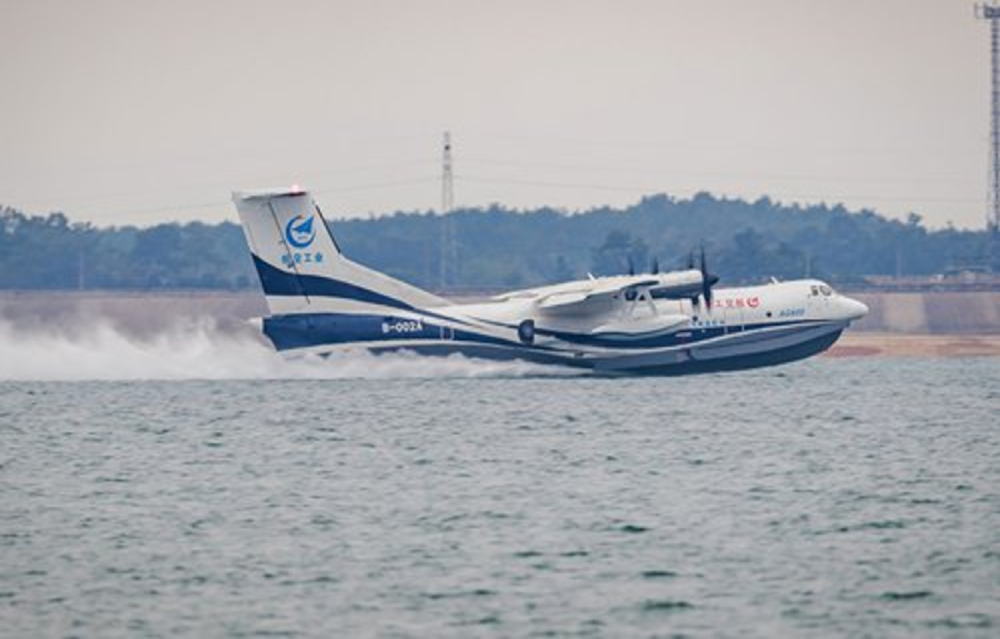
Source: Global Times (Photo by Aviation Industry Corporation of China)
As the United States devotes increased effort to operations in the Indo-Pacific, it should reexamine the value of seaplanes. Randy Schriver and Eric Sayers argued that, “the operational dilemmas faced by Indo-Pacific Command demand urgent attention.” Additionally, Sens. Jim Inhofe and Jack Reed have written of the need to “focus resources on key capability gaps to ensure U.S. forces have everything they need to compete, fight, and win in the Indo-Pacific.” The Marine Corps has gone so far as to develop a new force design to grapple with the challenges of operating in the region. The Air Force is also reportedly working on a new force design with a “focus on the challenges we have here in the Indo-Pacific.” Of key importance, almost all argue, are the challenge of logistics and the vulnerability of large, fixed bases.
In a theater like the Indo-Pacific, dominated by water and marked by a limited number of runways, seaplanes are at home. The utility of seaplanes lies in their ability to operate from water. Seaplanes have no need for runways or fixed facilities. Their base is wherever water is. Some seaplanes — amphibians — can operate from both land and water, further increasing their flexibility. The ability to operate from any body of water vastly complicates any enemy attempts to find or target them. Seaplane tenders — ships designed to repair and maintain seaplanes — and dispersed infrastructure can support sustained seaplane operations from the ocean. This combination of capabilities could prove potent in the Pacific. American planners should consider these highly capable aerial vehicles in future analyses, wargaming, and experimentation.
Seaplanes played an integral role in U.S. military operations from the early 1900s into the 1950s. In World War II, seaplanes were omnipresent in the Pacific. They attacked a mini-submarine outside Pearl Harbor minutes before the war started, sighted the Japanese carrier fleet at Midway, bombed enemy shipping, laid mines, rescued countless downed airmen, and performed a myriad of other tasks to include flying Fleet Adm. Chester Nimitz to sign the Japanese surrender document.
After World War II, the proliferation of runways on land and competing budget priorities curtailed American seaplane development. Nevertheless, the last U.S. investments in seaplane technology and operating concepts, the 1950s era Seaplane Striking Force, also showed significant promise. The R3Y Tradewind could carry a 50,000-pound cargo payload out to 1,000 miles. The P6M Seamaster, cancelled to fund the Polaris ballistic missile and the Navy’s carrier programs, could travel at high-subsonic speeds (Mach 0.9 at sea level) and deliver 30,000 pounds of weapons with a combat radius of 1,000 miles. Both aircraft could be reconfigured to perform the air-to-air refueling mission. And they could do this all without a runway.
Seaplanes do have real limitations. Their requirement to operate from water means they typically pay some performance penalties such as slight increases in drag and empty weight, although the P6M Seamaster performed better than some contemporary land-based aircraft. Seaplanes also need infrastructure to support their operations from either water or land: fuel stores, tenders or maintenance facilities, and weapons storage. But land-based aircraft also require these elements. Though seaplanes can be stymied by bad weather just as land-based aircraft can be, even the 1950s-era seaplanes could operate in up to nine-foot seas amid approximately 25 to 30 mph winds. And, given the lack of seaplane development in the U.S. military since the 1950s, or operations since 1960s, there would be a learning curve to overcome when reintroducing such aircraft to the fleet. Currently, Japan and Canada represent the only two allied countries building large seaplanes — and those of Canada are designed as firebombers. The efficacy of purchasing pre-existing or even modified seaplanes would ultimately depend on any envisioned role. More than likely, building a potent military capability would require investment in a purpose-designed military seaplane.
In short, seaplanes are no panacea. Nothing is. Instead, strategists should consider the cost and limitations of each system or concept of operations relative to the capability they provide. However, seaplanes offer a capable and survivable platform for a variety of missions — transport, refueling, strike, search and rescue, and others — in water-dominated theaters.
Potential Operating Concepts: Disruptive Thinking
The challenge of operating military forces in a theater dominated by water, like the Indo-Pacific, can be ameliorated by using aircraft meant to operate from the sea. The use of seaplanes could enhance America’s ability to resupply distributed marine forces, conduct air-to-air refueling, or perform search and rescue operations. Additionally, seaplanes could play an integral role in future stand-off strike warfare.
Expeditionary advanced base operations
The Marine Corps’ expeditionary advanced base operations concept envisions “employing mobile, relatively low-cost capabilities in austere, temporary locations forward” to support joint operations. This concept could readily benefit from seaplane logistical support. The 1950s R3Y Tradewind could carry more payload faster, farther, and likely more cheaply than the V-22 currently flown by the U.S. military. Seaplanes can also support islands lacking runway space for C-130 or C-17 sized aircraft. Additionally, their ability to offload payloads directly onto a beach potentially removes the need for heavy equipment to transport missile batteries away from a landing strip.
A seaplane could land a platoon of marines and a missile battery on the beach of a small, remote island — too small of an island for C-130s and too much weight for V-22s — and continue to reposition or resupply those forces. This additional capability would challenge adversary reconnaissance efforts and contribute to ensuring Marine capabilities remain intact throughout a campaign. Overall, seaplanes could provide a flexible logistics capability for Marine Corps planners and the joint force more broadly. China’s development of the AG-600 seaplane is likely intended — in part — to provide such a logistics capability for the resupply of islands in the South China Sea.
Figure 2: R3Y Tradewind offloading marines and artillery during an exercise in the 1950s.
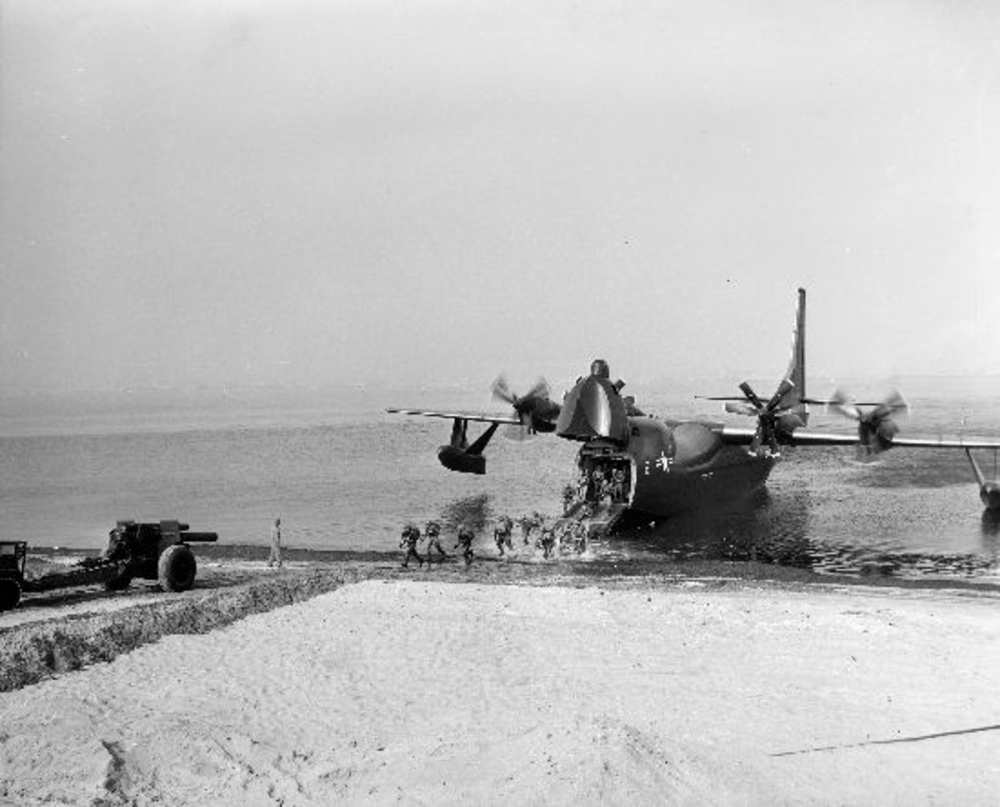
Source: Flickr (San Diego Air and Space Museum Archive)
Adaptive basing concept
The Air Force is currently experimenting with operating aircraft from austere fields in order to complicate adversary targeting efforts and sustain striking power. Here, seaplanes could provide tanker support for fighters and bombers operating in theater. A fully loaded KC-135 tanker might require over 10,000 feet of runway, while tactical fighters can operate from shorter runways. Strategic bombers could stage from bases outside adversary threat rings but would require multiple refuelings en route. Thus, it is very possible that suitable tanker bases are a more important constraint than fighter or bomber bases (obviously, strike aircraft also require weapons stores, but this is true regardless of the method of refueling them). Seaplane tankers, experimented with in the 1950s, would theoretically have unlimited runways, removing this limitation from planning. While there are real benefits in operating tankers from civilian airports instead of from water — namely the existence of fuel stores — these benefits are useless if the runway is cut, the fuel stores are destroyed, or the aircraft are eliminated on the ground.
Sea-based tankers could provide a mobile air refueling capability resistant to adversary surveillance and targeting efforts. Instead of searching the approximately 300 bases in the Western Pacific capable of handling tankers (a relatively manageable problem for the Chinese military), adversaries would be forced to search thousands of square miles of ocean, beaches, lakes, and lagoons for seaplanes and their supporting tenders or onshore facilities. Even if found, seaplanes would present a difficult target compared to an airfield due to their small size and mobility. It is impossible to crater the ocean. Furthermore, forcing an adversary to expend limited missiles targeting a difficult target like a seaplane would be beneficial to other American forces in theater.
Carrier air wing range
As numerous analysts have outlined, the Navy’s air wing has a range problem. Currently, the combat radius of carrier-based aircraft falls well within range of adversary weapons due to limited aircraft range and lack of tanker support. Carrier aviation is subject to the brutal math of limited carrier hangar space. More tankers mean less strike aircraft. Bigger tankers mean less strike aircraft. Strike aircraft acting as tankers shortens their lives, is relatively ineffective, and means less aircraft for strike missions.
Instead of relying on organic — or onboard — carrier-based tanking, the Navy could use sea-based seaplane tankers operating under carrier air wing control to provide tanker support. Under this concept, seaplane tankers could either operate with a tender as part of the carrier battle group or, for greater capability, operate downrange along the strike mission axis for a greater fuel offload capacity. For example, seaplane tankers in the Philippine archipelago could support a carrier operating deep within the Philippine Sea to hit targets in the South China Sea.
Current land-based tankers are vulnerable to attacks by aircraft, missiles, special operations forces, and other threats. Even if the land-based tankers and their bases survived an attack, they would be heavily tasked with supporting Air Force operations. The use of seaplane tankers for the carrier air wing would simultaneously allow the carrier to regain striking power by freeing up hangar space and increase its striking range.
Figure 3: An R3Y Tradewind refuels Navy fighters (F9F Cougars) in the 1950s.
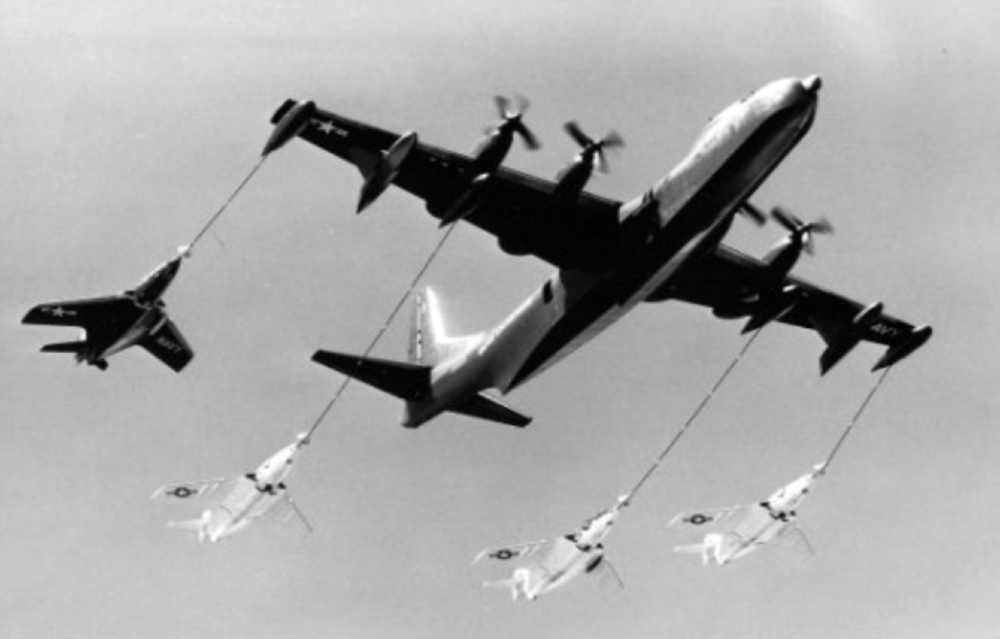
Source: U.S. Navy
Strike warfare
A more radical option would be to bring back the 1950s concept of the Seaplane Striking Force to augment current Navy and Air Force strike warfare, patrol, or anti-submarine warfare complexes. For example, a seaplane striking force of modern Seamaster and Tradewind equivalents could operate across the archipelagos, lakes, and oceans of the Indo-Pacific. These aircraft could deliver ordnance or conduct patrol missions over thousands of square miles with great mobility. A combination of converted submarines, seaplane tenders, barges, pre-placed fuel bladders, and dispersed facilities ashore could support this force. Such a concept could greatly improve the survivability of American power projection forces and offset adversary base strike capabilities such as China’s “Guam Killer” DF-26 missile. Such an improvement in American power projection would require opponents to invest large amounts of resources into finding and then targeting a modern seaplane striking force or accept its continued presence in a conflict.
A further utility of a seaplane striking force would be its ability to operate from the global commons — no basing rights or security partnerships necessary. Commanders could maneuver this force around the globe to respond to threats, deter aggression, or wage war. While it is assuredly a costly proposition, this represents an extreme application of seaplanes to some of the problems facing military planners in the Pacific. And, as always, cost should be judged relative to capability. Bombers destroyed on the ground and aircraft carriers at the bottom of the sea are also costly.
Figure 4: The P6M Seamaster striking from the sea.
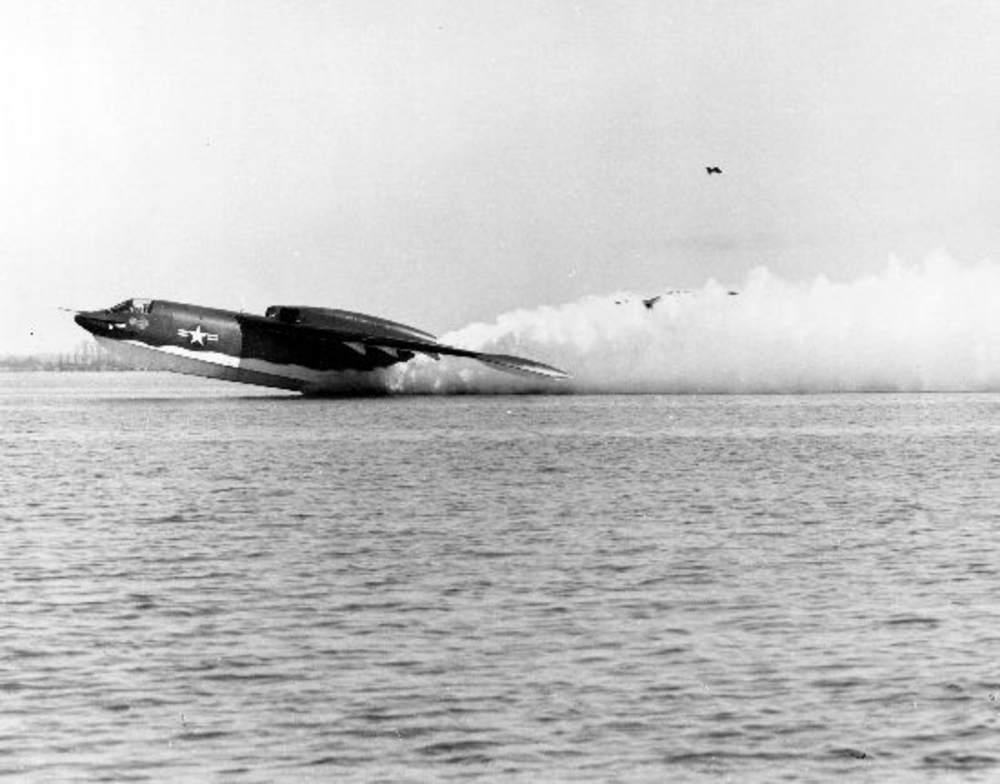
Source: U.S. Navy
Search and rescue
An additional application would be for seaplanes to provide a long-range search and rescue capability for downed aircrew and shipwreck survivors. Currently, Japan uses its US-2 seaplanes for this purpose. While America’s primary search and rescue system, the C-130 and HH-60 combination, brings its own unique capabilities, it lacks the speed and range to provide as effective support as a seaplane in the Pacific. A seaplane could transit at relatively high speed to a rescue area where it would land, recover personnel, and take off again.
The United States currently lacks this capability, a shocking fact given the hundreds of aircrew rescued by seaplanes in World War II. It is possible, for instance, that an American B-29 crew in 1945 had a better chance of rescue than a modern B-2 crew would. Seaplanes can provide a search and rescue capability ideally suited to the challenges of the Pacific. Additionally, seaplanes could be used at home by the Coast Guard just as the venerated HU-16E Albatross once was.
Looking Ahead
Seaplanes are an extremely adaptable category of air vehicles and could provide a welcome capability to military planners. Given the application of seaplanes across the joint force, initial funding and experimentation should be undertaken through the Department of Defense proper with the support of the individual services.
Moving forward, I recommend that the Department of Defense consider three specific actions. First, establish a joint-service exchange program with Japan’s US-2 seaplane squadron to build a small cadre of personnel who understand seaplane operations, their benefits, and their limitations (the author would be happy to volunteer for such a program). Second, include seaplanes in applicable wargames, analyses, and experimentation to study their use cases and efficacy. Third, provide limited funding to relevant individuals and organizations to examine the seaplane design space, determine capabilities given current technology, and develop realistic concepts for ongoing wargames and analyses.
While they are not an antidote to all of the challenges the U.S. military faces in the Western Pacific, seaplanes could provide numerous benefits to the joint force. Some authors are starting to write about the utility of seaplanes in more detail; this should only continue. Whether they are worth the cost and their own constraints is up to analysts and strategists to decide after considering them as an option. To disregard a whole category of military capability without due diligence would be a disservice to every servicemember potentially tasked with fighting America’s wars, and also to every legislator forced to choose where to allocate the nation’s finite resources.
2nd Lt. David Alman is an officer in the Air National Guard attending Specialized Undergraduate Pilot Training. In his civilian career, he has worked as an engineer, defense analyst, and management consultant. The views expressed here are his own and do not reflect those of his civilian employer, the United States Air Force, or the Department of Defense. The author has no financial interest in any seaplane development, although he admittedly would love to fly one.
Image: Wikicommons (Photo by U.S. Navy)

